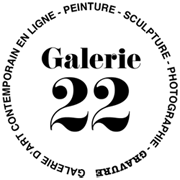RAYMOND GUERRIER
(1920-2002). Chevalier des Arts et des Lettres.
At the heart of young painting
Raymond Guerrier was born and grew up in Paris in a Breton family of modest means: his mother worked in a tobacco factory, his father, following a work accident, remained bedridden for most of his childhood. At a very young age, he showed an aptitude for drawing and painting and entered a photoengraving workshop as an apprentice (1). As he himself said, he learned painting on his own, by visiting Parisian museums and the major exhibitions at the Orangerie. In 1952, one of them, Still Life from Antiquity to the Present, made a deep impression on him. Moreover, his training as a photo-engraver taught him the art of constructing an image, of arranging forms and materials in order to obtain accuracy and balance, qualities that were evident very early on in his paintings. His first exhibitions were held directly on the Boulevard Saint-Germain where the young Guerrier sold his small views of Paris “on the sly” to walkers and passers-by.
In 1947, he participated in the Salon des Indépendant (2). In 1952, the Salon de la rue de Seine awarded him its prize and the Stiebel Gallery offered him his first exhibition. Guerrier presented a series of views of Paris and the ports of northern France. The exhibition was well received and the following year he was selected to participate in the Salon des Jeunes peintres held at the Galerie Drouant David. He won first prize with his painting Man in the City (3). His career was launched, and he was able to leave his job as a photo-engraver and, above all, Paris to settle in the Alpilles, which he had discovered the previous year during a trip to the Midi.
Guerrier’s painting alone embodies the spirit of “La Jeune Peinture”. Like all its representatives, Guerrier painted his immediate environment. The city, Paris, which he empties of its inhabitants and shows as a melancholic stage set in which masses of unctuous material with gradations of grey, ochre and dark brown are adjusted. It is all there in Guerrier’s drawing, in this material that densifies the volumes. This “hyper-structuring”, and the choice of an “austere”, deliberately “realistic” colour palette, are opposed to the abstract fashion that dominated the Parisian scene at the time, where colour is all seduction and drawing an unconscious lyrical impulse. Guerrier’s masters are to be found in the great painting of the past, the Italians, the Dutch and the French Realists. The profusion of still lifes and vanities testifies to this claimed tradition. Skulls, candles, fish, bouquets of flowers are Guerrier’s favourite motifs. Once again, these subjects are those of the immediate environment and daily life. They reveal his fierce desire to affirm his anchorage in reality, to paint his simple life, in tune with the world, far from a certain Parisian superficiality. His commitment.
In addition to his participation in the Salon de la Jeune Peinture and the Salon des peintres témoins de leur temps, epicentres of Parisian figuration, Guerrier produced several works for the Salon d’art sacré of the Musée d’Art Moderne. Some of the greatest architects, designers, painters and sculptors (Le Corbusier, Albert Gleizes, George Braque, Aurélie Nemours) were brought together around the question of sacredness. For Guerrier, as for many young figurative painters, the religious subject is one of the most important in the history of art: to approach it is of course to confront it, but it is also to reactivate a historical filiation. Guerrier will choose the great subject of the Crucifixion or an episode from the life of Saint Francis.
(Text Elisa Farran 2020)


